By Vi Hawes
This is the second in a series of Tech Tips blog posts exploring the Hybrid Flexible (HyFlex) model for classes and instruction in adult education programs. Check out the first post, Considering Use of the Hybrid Flexible Model in Adult Education.
I have piloted the Hyflex model at Pima Community College Adult Basic Education for College & Career since July 2021. At that time, it was the only HyFlex pilot but now we’re working with two other instructors who are also piloting their HyFlex classes this session.
 My Hyflex ESOL course meets on Mondays and Wednesdays from 9 am to 11 am. I offer both virtual and in-class modalities for my learners to choose from, in addition to an asynchronous option. The purpose of the Hyflex model is to provide our learners choice in how they engage in learning. The pandemic really pushed us into and gave us the opportunity to think about how to provide these learning options. Now, learners make choices based on their home situations, learning preferences, or other circumstances. In addition to offering choice, our goal is to create an equitable learning experience for our learners – no matter how they engage. That includes offering advanced and equitable AV (audio/video) experiences for both in-person and virtual learners and providing the same experience to our asynchronous learners.
My Hyflex ESOL course meets on Mondays and Wednesdays from 9 am to 11 am. I offer both virtual and in-class modalities for my learners to choose from, in addition to an asynchronous option. The purpose of the Hyflex model is to provide our learners choice in how they engage in learning. The pandemic really pushed us into and gave us the opportunity to think about how to provide these learning options. Now, learners make choices based on their home situations, learning preferences, or other circumstances. In addition to offering choice, our goal is to create an equitable learning experience for our learners – no matter how they engage. That includes offering advanced and equitable AV (audio/video) experiences for both in-person and virtual learners and providing the same experience to our asynchronous learners.
The Tech that Makes It Possible
The technology we are working with consists of two main pieces of equipment: Bluetooth speakers/microphones and a webcam. I’m currently using two Jabra Speaker 710s that are wireless and Bluetooth compatible. Syncing the two speakers together with all deployments ensures that a full classroom will have high-quality audio both from the instructor and the students in the room. The other piece of equipment is the OSBOT Tiny Lectern Webcam, which provides artificial intelligence (AI) visual tracking to follow the instructor around the room. This ensures instructor movement is captured for those working online. When the instructor walks through the room, the video will capture learner/group discussions. The camera tracking can also be turned off and set at a standstill.
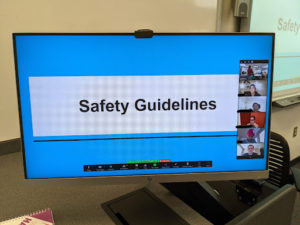 We also use this additional equipment to help our HyFlex pilots succeed:
We also use this additional equipment to help our HyFlex pilots succeed:
- Instructor computer: Used for accessing lecture materials, video conferencing setup
- Student computers in the classroom: Used for breakout groups and pair work for students who are in the classes to engage with those online
- SmartBoard: Used for projecting slides and content to in-person students as well as to online students
- Headphones with microphones: Used for breakout groups and pair work (The headphones are to prevent any overlapping voices and audio feedback because multiple students in the classroom might be working with people online.)
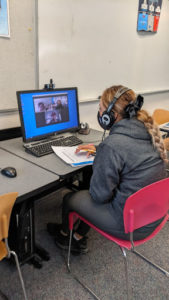 We also use the following applications:
We also use the following applications:
- Zoom video conferencing platform to broadcast the class to remote students
- D2L Brightspace Learning Management System for asynchronous learning
- Picktime, the online scheduling software students use to reserve their spots for an in-person class.
How It’s Gone So Far
We’ve experienced many successes and challenges in the pilot, but it gets easier with more experience. I’m feeling more successful with my current cohort than my first cohort. Compared to my first cohort, I have a consistent number of students attending the in-person modality (four students). In the first cohort, I struggled with getting at least one student to attend in person; there were concerns regarding the Delta Variant, and students’ home situations made it challenging for them to come to class.
In this cohort, my students are able to engage well with each other regardless of modality. I have made use of full class discussions with students, breakout groups, and student pairs to increase collaboration – all done with students in class and online working together. After overcoming a few hurdles regarding sound feedback, I was able to invite my in-person students to tune into Zoom when they need to do group work with their online peers. This has been great to see! I will note that it is usually difficult to make both modalities inclusive because it can be easier to focus on the in-person students than the online students. It takes practice to learn how to not forget about those students online!
Here are some additional challenges and successes I’ve noticed in the pilot:
Challenges:
- Technological difficulties (e.g., the camera doesn’t work, projector breaks down, audio issues, poor internet connections)
- Sometimes students from both modalities can’t see each other, making it difficult to provide a quality face-to-face experience. With only one camera, that camera is focused on the instructor most of the time and with only one Smartboard screen, it can only project one thing at a time. In-person students might not be able to see their online classmates most of the time.
- Difficulty encouraging students to attend in-person modality due to COVID-19 concerns, home situation changes, and lack of transportation.
- Getting accustomed to multimodal instruction and providing equal access for students.
Successes:
- Incorporating SmartBoard device into HyFlex instruction, making the presentation of instruction seamless for both modalities
- FLEXIBILITY! I had an instance where I needed all of my students to stay online for class and so initially equipping my students to be online was helpful.
- Learner choice and convenience. Students can choose from the three modalities available to them: online synchronous, in-person synchronous, or online asynchronous. Regardless of modality, students can still engage with their classmates and the materials and can get full participation credit.
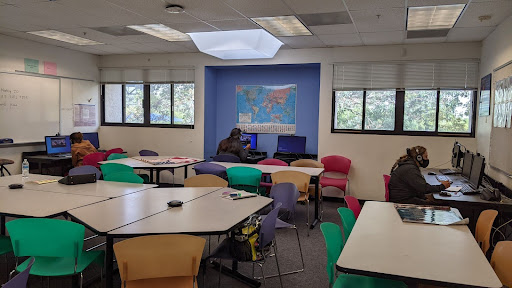
Hyflex has changed the way I work – with respect to flexibility and equity. The beauty of the Hyflex model is that it provides choice for learning preference and equal opportunity for every student to participate, which opens up opportunities for learning and connection. Many of our students learn differently; some need more one-on-one attention and some prefer to work independently. By giving these different options of being in-class with the instructor or being in the comfort of their homes, we can provide for these learning opportunities.

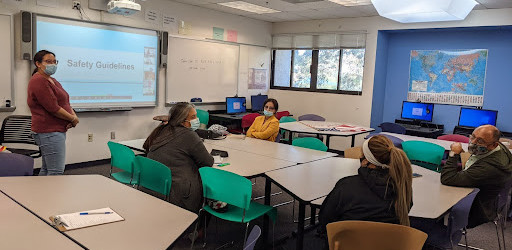

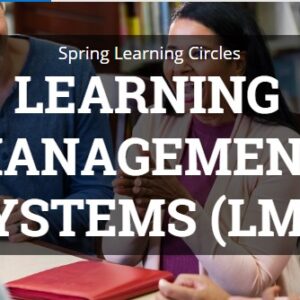

2 Comments.
Exciting review of an intriguing model. I imagine the tech difficulties were there and would like to know how much IT support was needed as well as training on devices for students. I think a video of actual instruction would be great to fully see how hyflex classes operate.
Hi Anson! This is Vi! Thanks for taking the time to read the blog post on my Hyflex classroom experience! We anticipated that there would be a learning curve in regards to the technology and so we have Pima’s IT team to support us with this. Prior to the Hyflex pilot, IT bought all of the equipment and met with us individually to go over each equipment and how they work. They were also available on call if we needed any assistance at the last minute. They are quick to respond to our inquiries and made our pilots a lot easier to execute. After we feel confident in using the tech provided for us, we are able to provide training for our students. The students also support each other during this time.
As for a recorded video of my instruction, I’d be more than happy to share that with you! I’d love to connect with you! Here is my email: ttle5@pima.edu